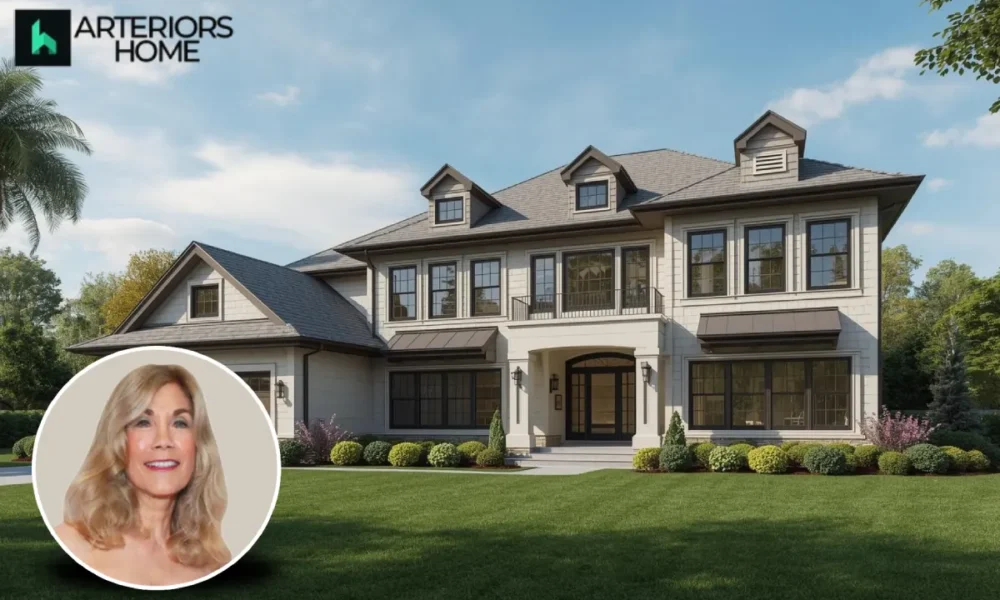he Barbi Benton house, known as the Copper Palace, is a 27,000-square-foot modernist masterpiece in Starwood, Aspen, Colorado. Designed by architect Bart Prince between 1989 and 1993, this seven-story residence features four copper-clad pods, a two-story disco, a rotating bed, and a ballroom that seats 150 guests.
When you think of celebrity homes, few compare to the architectural wonder that Barbi Benton and her husband George Gradow built in the late 1980s. This isn’t your typical mountain retreat.
The Copper Palace sits on 40 acres in Starwood, one of Aspen’s most exclusive neighborhoods. Getting there requires passing through a manned checkpoint and driving past properties owned by international royalty and billionaires.
What started as a search for an architect to design a traditional English Tudor home turned into something completely different. Benton and Gradow contacted Bart Prince, an Albuquerque-based architect known for his experimental designs. They initially thought they had called the wrong person.
But Prince’s vision changed everything.
Bart Prince’s Architectural Vision
Prince designed the Copper Palace between 1989 and 1993. The project took over four years to build and required solving complex challenges.
The site presented immediate obstacles. The steep hillside needed a design that would minimize the building’s footprint while maximizing views. Local building codes imposed height restrictions. Geological considerations affected foundation planning.
Prince’s solution was brilliant. He created four structural pods built around steel-and-concrete staircases. These pods essentially lifted the house off the ground. Rounded wings holding living spaces cantilever out from each pod, one over another.
The architect chose copper as the primary exterior material for specific reasons. He wanted something monolithic, lightweight, and durable. Most importantly, he wanted a material that would change naturally with the environment and require no painting or treatment.
The entire upper structure, except for glass areas, is clad in copper above, below, and around the perimeter. The building steps down the hill at the same angle as the natural slope.
Breaking Down the 27,000 Square Feet
The Barbies Benton house spreads across seven floors with three bedrooms and seven bathrooms. But those numbers don’t tell the real story.
The couple’s wish list was extensive:
- Separate swimming pools at different temperatures (hotter for her, colder for him)
- A room that seats 150 for dinner
- A cloakroom for 200 coats
- Three dressing rooms for Benton, one for Gradow
- A screening room
- A massage room
- A gym
- A music room
- Yoga space
- Offices for everyone
- A disco for at least 100 people
The main living area welcomes visitors with curved walls, plush sofas, and high ceilings. A band of windows wraps around the curved wall, offering views down the valley. Benton wanted to call the house “Starship” because it resembles the Starship Enterprise.
A 40-foot sliding mural, based on multiple Toulouse-Lautrec paintings, conceals a ballroom. The room doubles as a dance studio, yoga space, and karaoke venue.
The Two-Story Crystal Disco
The disco became the project that convinced Gradow to let Benton handle all interior design.
When a professional designer quoted $75,000 just for his fee, with all materials extra, Benton took over. She bought the entire contents of a pyrite mine. She added small crystals in real quartz and massive fiberglass replicas to create a forest of crystals that mark different dance zones.
Special equipment came from her favorite Hawaii club when it closed. The conversation piece is a machine that fires perfect cannonballs of dry ice straight at dancers. The smoke passes harmlessly through people between courses when guests break for dancing.
The disco also inspired Benton’s signature touch throughout the house: 47 doors, each painted with copies of famous artworks. Each painting relates to the room behind it. The men’s room door features a detail from a Max Ernst work, adjusted so the figure appears to be using the facilities. The ladies’ room door shows an exact copy of Salvador Dalí’s “Young Virgin Auto-Sodomized By The Horns Of Her Own Chastity.”
The Master Bedroom’s Rotating Bed
The master bedroom features dramatic lighting and a ceiling covered end to end in faux wisteria vines. Tiny lights twinkle from underneath the hanging foliage.
The centerpiece is a rotating bed that circles 360 degrees on tracks recessed into the floor. Benton and Gradow originally wanted the bed to roll out onto the terrace for breakfast in the snow. They forgot to account for the door frame, so that didn’t work. But the bed still rotates completely.
A couch is built into the foot of the bed. The handrails throughout the house are Perspex tubes filled with marbles.
Custom Interior Design Elements
Benton handled every interior element personally. She studied exotic woods to select exact flooring. She attended a crystal show in Phoenix to handpick amethyst, quartz, and pyrite for the disco. She worked directly with over 30 artists who created commissioned pieces.
The living room’s half-moon shape presented furnishing challenges. Benton designed and built massive custom sofas. The larger one seats 27 people. The family has played musical chairs on it many times.
The living room floor features a mix of 17 hardwoods, all cut and numbered in Kentucky, then reassembled on site like a jigsaw puzzle.
When orbicular granite for Gradow’s bathroom ran out two pieces short, Benton contacted the Australian mine’s previous customers and convinced them to part with some.
Other unique features include:
- Fiber-optic lights buried in plastic resin office desks
- A waterfall fountain with wooden ducks parading in front
- Another fountain studded with orthoceras fossils
- A five-floor Mexican-style “Jack and the Beanstalk” mural visible through the glass elevator panel
- An egg-shaped screening room modeled after Grauman’s Chinese Theatre with speakers embedded in totem poles
- Renaissance Revival dining tables and chairs that once belonged to industrialist Andrew Carnegie
The Copper Palace’s Timeless Design
After 18 years in the house (as of 2014), Benton and Gradow had not redecorated anything.
“It was ahead of its time when we did it, and the finishes are still ahead of the time,” Benton said. “It looks like it could have been built yesterday. Nothing is dated. It’s so alive.”
The copper exterior continues to age naturally, merging with the mountain environment just as Prince intended. Different stages of copper oxidation create interior drama in areas where the material is used.
Inside Barbi Benton’s Creative Process
Most of Benton’s interior designs came to her in dreams. She would wake up with visions of specific rooms and immediately sketch them out.
“George has no idea how to decorate till he sees it firsthand,” Benton explained. “Then he’d say, ‘I like it, but I want it wilder.’ So that’s what I’d try to give him.”
Benton brings diverse experience to design. Beyond her modeling career with Playboy and relationship with Hugh Hefner, she toured for 12 years as a singer-songwriter. She had a top-five country hit in 1975 with “Brass Buckles” and appeared on Hee Haw.
“I come from the side of the brain that makes people good at music and art,” she said.
Before the Copper Palace, Benton designed the guest house at the Playboy Mansion. She created it to look hundreds of years old, buying an old barn and using the wood with charming tiles for a country feel.
Location and Neighborhood
The house sits in Starwood, a private gated community just outside Aspen’s main ski resort area. Residents include international royalty, business moguls, and celebrities.
Getting to the property requires passing the airport’s private jets, clearing a security checkpoint, and driving past estates valued at over $100 million. Prince Bandar of Saudi Arabia owned a $135 million spread nearby.
The Copper Palace perches high on Starwood mountain, with its four cantilevered copper pods appearing to slip down the hillside. The 40-acre lot offers unobstructed views down the valley.
Privacy Meets Entertainment
Benton and Gradow had specific requirements as parents of two young children when building began. They wanted a home where a dinner party for 150 was possible, but privacy remained paramount.
Prince’s pod design solved both needs. The vertical and horizontal arrangement separates living areas completely.
“It’s almost like you’re in your own individual house,” Prince said. “It’s integrated, but no one’s walking past your room to get through the house.”
Each pod provides unobstructed views. The separation means family members can have completely different experiences in the house simultaneously.
The Architectural Legacy
The Copper Palace earned recognition as one of the finest modern houses in America. Bart Prince, who trained under Bruce Goff, has built some of the most unusual and acclaimed residences in the American West.
His Corona del Mar residence for art collector Joe Price won the Architectural Record House of the Year award in 1991, Prince’s third such honor. The magazine described it as “not restrained by traditional notions of good taste.”
The Copper Palace takes that approach even further. It represents Prince’s philosophy that no work of architecture should be like any other.
“You change the site, you change the client, you change any single aspect of the problem and the solution changes,” Prince explained. “The resulting building becomes a ‘portrait’ of the client.”
What Makes This House Unique
The Barbi Benton house defies easy categorization. Walking through it over five hours takes visitors through constantly shifting colors, textures, architectural styles, and eras.
The main living area that initially feels futuristic becomes normal after experiencing the rest of the house. Seven floors twist through the four stairwell pods. Every turn brings new visual stimulation.
Benton acknowledges the house isn’t for everyone. “We honestly didn’t care whether anyone would like it or not; we built it for ourselves,” she said. “But it’s elegant. I’ve never heard anyone say they don’t like it, though a lot of people say they couldn’t live in it.”
The house says something specific about its owners. “It says we’re not your average people. It says we’re fun, with a capital ‘F,'” Benton explained.
Current Status and Value
The Copper Palace remains the primary residence for Benton and Gradow in Starwood, Aspen. While the exact current value hasn’t been publicly disclosed, comparable properties in the Starwood area command prices well into the tens of millions.
The house gained additional media attention over the years, including features in design magazines and a segment on HGTV that showcased its extreme interiors.
Real estate experts consider it one of the most distinctive celebrity homes in America. Its combination of world-class architecture, custom interiors, and prime Aspen location make it irreplaceable.
Lessons From the Copper Palace
The Barbi Benton house offers insights for anyone considering custom home design:
- Work with architects who match your vision: Benton and Gradow initially wanted English Tudor but ended up with something completely different because they found the right architect.
- Don’t be afraid to take creative risks; The most memorable spaces in the house came from Benton’s boldest ideas.
- Consider how you actually live: Prince’s design addressed specific lifestyle needs, from separate pool temperatures to privacy within a large entertaining space.
- Choose materials wisely: Prince’s selection of copper provided beauty and durability without ongoing maintenance.
- Personal touches matter most: The 47 painted doors, custom sofas, and hand-selected materials make the house uniquely theirs.
Ready to explore extraordinary properties in Aspen and beyond? Whether you’re looking for architectural masterpieces or traditional mountain retreats, contact us today for exclusive listings and personalized property tours.




No Comment! Be the first one.